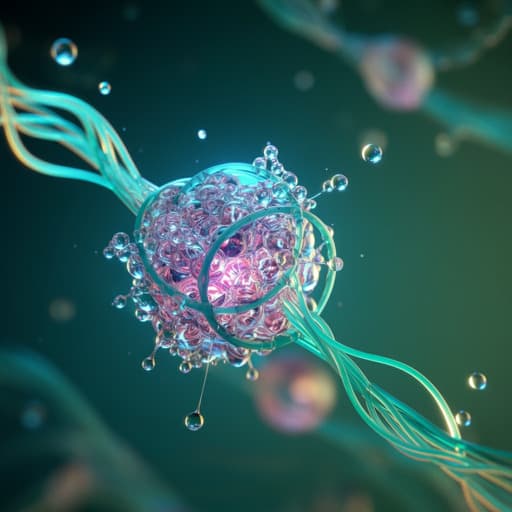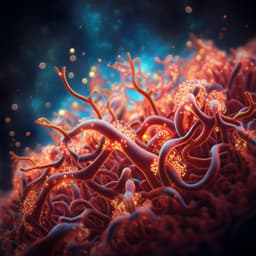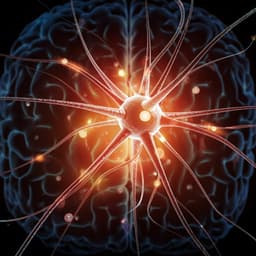
Engineering and Technology
Application of 3D-printed tissue-engineered skin substitute using innovative biomaterial loaded with human adipose-derived stem cells in wound healing
H. Fu, D. Zhang, et al.
Discover groundbreaking advancements in wound healing with 3D-printed skin substitutes! This innovative research, conducted by Huijuan Fu, Dequan Zhang, Jinshi Zeng, Qiang Fu, Zhaoyang Chen, Xuer Sun, Yi Yang, Shiyi Li, and Minliang Chen, showcases a novel biomaterial combined with human adipose-derived stem cells for enhanced healing outcomes.
~3 min • Beginner • English
Introduction
Skin, the largest soft-tissue organ, is prone to injury (burns, trauma). For large-area defects, autologous skin/flap transplantation is limited by donor scarcity, graft survival, scarring, and inability to regenerate appendages. Many existing skin substitutes function primarily as dermal scaffolds and often require secondary grafting due to slow vascularization and delayed epithelialization. Traditional cell seeding on scaffolds leads to imprecise control of cell distribution/density and is time-consuming. 3D bioprinting offers timely, high-throughput, repeatable fabrication of scaffolds with controlled macro/micro-architecture and uniform cell distribution, enabling personalized constructs. Stem cell–based approaches, especially using readily available adipose-derived stem cells (ADSCs), show promise. Adipose tissue dECM retains ECM components that support cell behavior and angiogenesis and can form hydrogels. GelMA–HAMA hybrid hydrogels provide printability, mechanical properties, and biocompatibility. This study aims to fabricate a 3D-printed skin substitute combining adipose dECM, GelMA, HAMA, and hADSCs, and to evaluate its in vivo efficacy in wound healing.
Literature Review
- Clinical standards such as autologous skin or flaps are constrained by limited donors, graft survival, scarring, and lack of appendage regeneration.
- Existing dermal scaffolds often require secondary grafting due to slow vascularization and epithelialization.
- dECM from adipose tissue preserves complex ECM composition and bioactive cues, promoting cell adhesion, proliferation, differentiation, angiogenesis, and tissue repair while minimizing immunogenicity.
- GelMA and HAMA hydrogels, especially when methacrylated and photocrosslinked, offer suitable rheology, mechanics, biocompatibility, moisture retention, and printability; GelMA provides cell-adhesive motifs, while HAMA promotes wound healing but needs crosslinking for mechanical strength.
- ADSCs are advantageous due to ease of harvest, high proliferation, low immunogenicity, and paracrine effects supporting wound healing.
- Prior studies indicate hADSC-loaded hydrogels enhance vascularization essential to skin regeneration; hybrid GelMA–HAMA systems can mimic skin ECM and have been used in various tissue engineering contexts.
Methodology
- Cells: Commercial hADSCs (HUXMD-01001) cultured in DMEM/F12 with 10% FBS and 1% penicillin–streptomycin at 37°C, 5% CO2. Passage at 80–90% confluence with 0.25% trypsin-EDTA; P4 cells used and counted.
- Adipose tissue collection and decellularization: Human adipose tissue from liposuction donors with consent. Decellularization via modified Flynn method: triple freeze–thaw; centrifugation; 0.25% trypsin-EDTA digestion; isopropanol extraction cycles; nuclease (1000 U/mL) and type II lipase digestion; repeated isopropanol extraction. All solutions with PMSF and antibiotics. Lyophilize 48 h.
- Decellularization assessment: DAPI staining of paraffin sections for nuclei; DNA quantification (genomic DNA kit; NanoDrop) of native adipose vs dECM.
- dECM pre-gel preparation: Lyophilized dECM powdered and digested in 0.5 M HCl with pepsin (10 mg dECM:1 mg pepsin) for 72 h at RT; neutralize with 10 M NaOH; adjust ionic strength with 10× DMEM/F12 on ice to physiological conditions to obtain thermo-sensitive pre-gel.
- Bioink preparation: GelMA dissolved in DMEM/F12 at 55°C; sterile filtered (0.22 μm). HAMA dissolved, stirred overnight, pasteurized (70°C 30 min/4°C 10 min ×3). Mix to obtain precursor with final concentrations: 1.125% (w/v) dECM, 7.5% (w/v) GelMA, 1% (w/v) HAMA. Add LAP photoinitiator to 0.25% (v/v). Mix hADSC suspension 1:9 with precursor for final 1.0×10^7 cells/mL.
- Rheology: Discovery HR-20 rheometer; 40-mm parallel plate, 1-mm gap; strain 2%, frequency 1 Hz; temperature ramp 0→35°C at 3°C/min to determine G' and G'' and crossover temperature.
- SEM of crosslinked hydrogel: Photocrosslink precursor (405 nm UV, 10 s), fix, dehydrate, dry, expose cross-section, sputter coat with iridium; SEM (S-4800) at 15 kV, 10 mm working distance; analyze porosity and pore size via ImageJ.
- 3D bioprinting: Extrusion-based printer (EnvisionTEC). Parameters: 27G nozzle (200 μm ID), pressure 0.8–1.2 bar, speed 3.2–5.6 mm/s, scaffold diameter 8 mm, strand spacing 800 μm, layer height 180 μm, 4 layers. After each layer, 405 nm UV for 4–5 s to photocrosslink GelMA/HAMA. Store constructs in DMEM/F12 +10% FBS +1% P/S at 37°C, 5% CO2.
- In vivo model: 24 male Balb/c mice (6 weeks). Under anesthesia (1% pentobarbital sodium, 40 mg/kg), create two 8-mm full-thickness dorsal excisional wounds; suture 8-mm inner diameter rubber rings to limit contraction. Randomize into 4 groups: (A) full-thickness skin graft; (B) 3D-bioprinted skin substitute (experimental); (C) microskin graft; (D) control. Cover with semipermeable membrane and bandage; individual housing. Photograph and measure wound area (ImageJ) on days 0, 7, 10, 14; compute healing rate.
- Histology: HE (days 7, 14) for epidermal/dermal structure, inflammation; Masson’s trichrome (day 14) for collagen deposition/organization; quantify collagen area percentage via ImageJ.
- Immunohistochemistry: CD31 (1:4000) to assess angiogenesis; DAB visualization; hematoxylin counterstain; count capillaries in five random fields/sample.
- Perfusion: Laser Doppler perfusion imaging (PeriCam PSI) on days 7 and 14; analyze perfusion units in ROI with PIMSoft.
- Statistics: Mean ± SD; t-test for two-group comparisons (normality, homoscedasticity met); one-way ANOVA for multiple groups. Significance: P<0.05 (*), **P<0.01, ***P<0.001, ****P<0.0001.
Key Findings
- Decellularization: dECM contained 24.5 ± 7.1 ng DNA/mg, below the <50 ng/mg criterion; DAPI showed no nuclei.
- Thermo-responsiveness: dECM pre-gel free-flowing at 0–4°C, gels near 37°C.
- Rheology of dECM–GelMA–HAMA precursor: Storage and loss moduli decreased from 0–35°C with crossover at ~17.5°C (G'≈G''≈8 Pa), indicating gel–sol transition; below 17.5°C, elastomer-like; above, fluid-like.
- Microstructure: Crosslinked composite hydrogel exhibited a uniform, highly porous 3D network with 65% porosity and average pore size 73 ± 18 μm.
- Printability/stability: 8-mm diameter, grid-like scaffolds printed with uniform pores remained structurally stable after 3–4 h incubation at 37°C.
- Wound closure: Group B (3D-bioprinted substitute) showed faster healing rates vs Group D (control) at days 7 and 10 (P<0.01) and day 14 (P<0.05). No significant differences among Groups A, C, D at any time point.
- Histology: Day 7—Group B wounds largely epithelialized with dense collagen and minimal inflammation; Groups A, C, D showed more inflammation and incomplete epithelialization (C, D). Day 14—Group B exhibited skin structure comparable to Group A and superior to C and D; collagen fully filled dermal defects with less inflammatory infiltration.
- Collagen deposition/organization (Masson, day 14): Group B had moderate thickness, dense, orderly collagen; collagen area percentage significantly higher than Groups C and D.
- Angiogenesis (CD31): Capillary counts significantly higher in Group B vs A, C, D on day 7; on day 14 higher than A and D, not different from C.
- Perfusion (Laser Doppler): Day 7—Group B perfusion higher than others, significantly higher than Group A; no significant difference among B, C, D. Day 14—Group B higher than others, significantly higher than Group D; no significant differences among A, B, C.
- Overall: 3D-printed dECM–GelMA–HAMA scaffolds with hADSCs accelerated wound healing, improved epithelialization, collagen deposition/alignment, reduced inflammation, and enhanced angiogenesis and perfusion.
Discussion
The study demonstrates that combining adipose-derived dECM with GelMA–HAMA yields a printable, biocompatible bioink that supports hADSC encapsulation and structural fidelity post-printing. The dECM preserves native biochemical cues, while GelMA provides cell-adhesive motifs and HAMA contributes to moisture retention and photocrosslinkable mechanics, addressing dECM’s intrinsic shortcomings (weak mechanics, slow gelation, low print resolution). Rheological tuning (printing above ~17.5°C to avoid needle clogging) and photocrosslinking enabled fabrication of stable, porous constructs with pore size and porosity conducive to cell viability and tissue ingrowth.
In vivo, the 3D-printed hADSC-laden constructs significantly accelerated closure versus control and improved key phases of healing—re-epithelialization, collagen deposition and organization, angiogenesis, and tissue perfusion—indicating synergistic effects of the biomimetic scaffold and hADSC paracrine activity. Outcomes matched or surpassed autologous graft or microskin in several metrics by day 14, suggesting this approach could offer an alternative when donor skin is scarce. These findings support the hypothesis that a dECM–GelMA–HAMA bioink with hADSCs can enhance wound repair by providing both a favorable microenvironment and therapeutic cells with pro-angiogenic and immunomodulatory effects.
Conclusion
A thermo-responsive dECM–GelMA–HAMA precursor can be 3D-printed into stable, porous skin substitutes encapsulating hADSCs. The constructs accelerate wound healing in vivo, promoting re-epithelialization, orderly collagen deposition, reduced inflammation, increased angiogenesis, and improved blood perfusion, thereby enhancing healing quality. The work provides a preclinical foundation for 3D bioprinted, cell-laden skin substitutes in regenerative medicine. Future research should optimize bioink composition and mechanics, align scaffold degradation with tissue formation, and evaluate long-term cell fate and functional regeneration of skin appendages.
Limitations
- Mechanical strength of the gelatinous composite scaffold remains insufficient for clinical translation of load-bearing or mechanically stressed skin regions; incorporation of synthetic polymers (e.g., PCL, PLA) may be needed.
- Need to match scaffold degradation/absorption with the rate of tissue formation and to prolong survival/viability of encapsulated stem cells.
- Challenges remain in bioprinting fully functional skin with appendages (vascular networks, hair follicles, sweat glands, nerves) and pigmentation.
- Potential printing-related cell stress (shear, temperature, photo-crosslinking) requires further assessment of cell phenotype, migration, survival, and differentiation.
- Study limited to a small animal model and short-term endpoints; longer-term, larger-animal studies and dose/parameter optimization are warranted.
Related Publications
Explore these studies to deepen your understanding of the subject.







